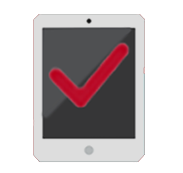Explanation

Electronic marking is intuitive, simple to use and it makes a logical choice for facilitating quick and comprehensive electronic online feedback to your students.
Electronic marking at Huddersfield
At the University of Huddersfield, electronic marking functionality is provided by Grademark which is part of the Turnitin assignment submission tool, there is more help on using Grademark available, and many other useful guides in the Brightspace How to Guides section of iPark .
What does Electronic Marking give me?
Electronic marking software can present full-featured digital environment for grading and commenting on student work. After grades are posted by the instructor, students can access their feedback to review comments and print or save a copy of the graded files. Some of the features of Electronic Marking include:
- Inline highlighting of text and marginal commenting.
- Predefined palettes for inline comments including standard proofreading marks, punctuation and common grammatical errors (to insert one of these marks into the text, you simply click on the palette button and it shows up as a mark on the paper and links to an explanation of its meaning)
- User-defined palettes for inline comments so that you can create your own one-click palette for your frequently-used comments.
- A generous space for general comments, which is where you write paragraphs of commentary as you would at the end of a student’s paper.
- User-defined rubrics, which can be used either with or without grade calculation – the rubric tool offers several different options for setting the calculation of grades (by set numbers or percentages) and makes the construction of new rubrics very easy.
Benefits of Using Electronic Marking:
While the environmental and reduction in travel requirements are a great benefit of electronic submission and feedback, there are other associated benefits for both tutors and students when using electronic marking.
Tutor Benefits
- Once familiar with the software, tutors may benefit from the time taken to mark assignments.
- Tutor’s comments are not limited by the amount of white space available on the paper they are grading.
- Access to a large pre-populated set of comments on grammar, punctuation and more that are easily used to annotate your submissions.
- The ability to create custom sets of pre-populated comments that can be applied to specific text or more general areas of the paper easily,. This saves time when correcting common or repetitive mistakes. The pre-populated comment sets can be shared with other tutors creating conformity of grading across disciplines, cohorts or projects.
- Some electronic marking software runs on mobile devices. Turnitin launched an iPad app in August 2013 that allows you to mark work on the iPad, including while you’re not connected to the internet.
Student Benefits
- Students receive their feedback privately (away from the classroom environment), reducing the stress of feeling pressured into sharing their grades with peers.
- Students can access their grade and feedback as soon as it is available regardless of their location.
- Students no longer have the problem of deciphering tutor handwriting, meaning accessibility and readability are enhanced.
- Clarity of feedback is enhanced in context. Feedback is of benefit to students, the ability to directly link feedback comments to specific areas of text can remove confusion that students may encounter when trying to ascertain the relevancy of a comment.
Good Practice Using Electronic Marking:
Good practice in providing electronic feedback via electronic marking follows the same best practice guidelines that should be applied to the delivery of all feedback;
- Feedback is best provided as soon as possible after the assessment took place, so that the learning from feedback can still be connected to the assessment content.
- Feedback should be critical but supportive to learning so as to encourage a student’s confident scrutiny of their future work.
- Feedback should, where possible, be directly related to learning outcomes and given assessment criteria so that students are very clear on what was and will be expected of them.
- Feedback should be given with care and attention to standards of respect for diversity and individuality and should rarely be directed at the student but rather at their work.
- Feedback should be more than just ticks or crosses. Tempting as it is to put ticks beside things that are correct or good ticks don’t give much real feedback. It takes a little longer to add short phrases such as ‘good point’, ‘I agree with this’, ‘yes, this is it’, ‘spot on’, etc, but such feedback comments do much more to motivate students than just ticks the same applies with crosses – it is worth spending some time explaining what is wrong.
References to Scholarly Articles:

Buckley, E., & Cowap, L. (2013). An evaluation of the use of turnitin for electronic submission and marking and as a formative feedback tool from an educator’s perspective. British Journal of Educational Technology, 44(4), 562-570.

Sterngold, A. (2012). Change : The Magazine of Higher Learning Confronting Plagiarism : How Conventional Cyber-cheating, (November), 37–41.

Youmans, R. J. (2012). Studies in Higher Education Does the adoption of plagiarism- detection software in higher education reduce plagiarism ?, (November).